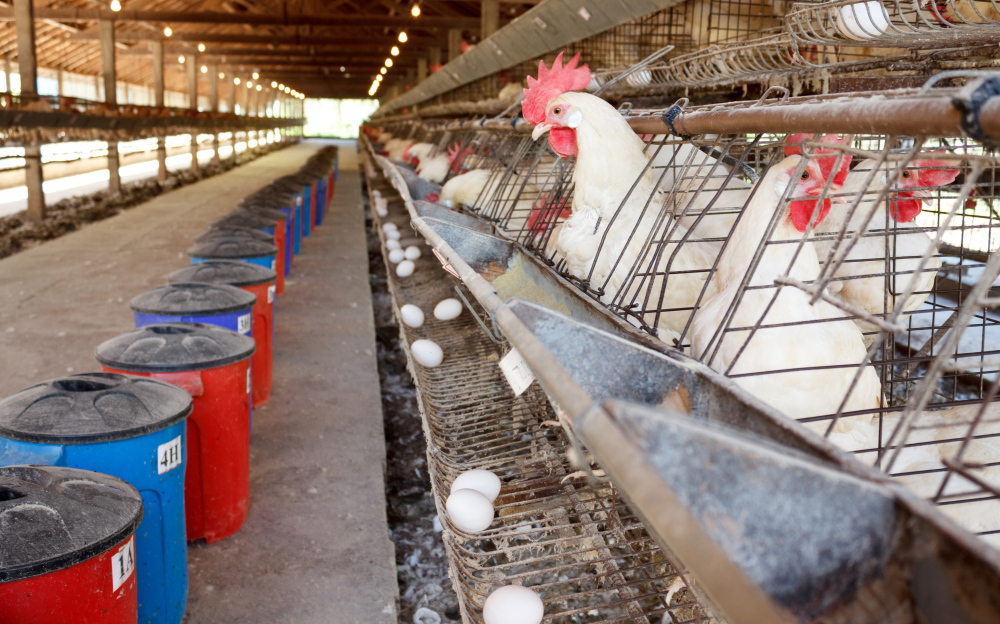Located within 300 miles of New York, Philadelphia and Washington, Sauder’s Quality Eggs in Pennsylvania is ideally situated to serve the more than 50 million consumers in the Northeast.
But some of the trucks that might have rolled out of Sauder’s Lancaster County facilities toward Manhattan are now heading about 2,000 miles west.
“We’re getting lots of calls from California,” said Paul Sauder, 64, the owner, wearing a white protective suit and speaking over the din of 17,000 clucking brown hens while on a visit to a barn west of Philadelphia. “Stores are worried they won’t be able to meet demand after Jan. 1.”
That’s when a California law takes effect that requires eggs sold in the nation’s most-populous state to come from farms meeting minimum living standards sought by animal-welfare groups – chiefly more space in their cages.
Passed by the state’s voters in a 2008 initiative and expanded two years later, the rules have drawn a lawsuit from a half-dozen states and concern that the idea will spread to other agricultural products. Consumers may be affected too: California is the biggest egg-consuming state, importing more than 30 percent of its eggs, and its requirements affect farms across the country.
Rising meat prices have made eggs a popular alternative and driven per-capita consumption to its highest level in decades. California’s law could push up grocery prices as farmers boost their use of costlier cage-free housing or reduce the number of birds in their cages.
Sauder’s cage-free chickens are laying eggs that command a premium and are finding ready buyers in California.
“It wouldn’t normally make any economic sense to transport eggs to California when I can sell in New York,” said Sauder, president of R.W. Sauder Inc. “But if the premium’s high enough, I can find a truck or two.”
He also has birds living in cages that meet the industry standard: an average of 67 square inches for each, or a patch of ground slightly larger than 8 by 8 inches.
California says that when nine or more chickens are housed in a cage it must offer an average of at least 116 square inches – roughly equal to a 10.7-inch square – of floor space for each bird. That has farmers rushing to modify their coops while California agriculture agents crisscross the country certifying operations.
In Iowa, Jim Dean is bringing a 1.5-million-bird production facility into compliance by reducing density, leaving him with 800,000 birds.
“This will reduce supply and drive up prices,” said Dean, chief executive officer of Centrum Valley Farms, an egg producer based in Sioux Center.
A California inspector visited his farms in Iowa and Ohio in June. After a full day of checks for food safety, also required under the law, along with an “enclosure” audit in which the amount of cage space in a barn was compared to the number of birds within, Dean’s business received certification.
Disagreement over how to apply the law is making matters worse for Dean and other producers. The California Department of Food and Agriculture interprets the rules as requiring the 116- square-inch standard. The Humane Society says the initiative voters passed really means cage-free, raising the possibility of a lawsuit.
And trade groups that fought the new egg rules haven’t given up. A federal suit filed by six states, including Iowa, the No. 1 U.S. egg producer, said the law is an unconstitutional restraint on interstate commerce. The case was thrown out in October; the states are appealing.
“I’m not sure I want some bureaucrat telling a farmer the best way to care for animals,” said Dave Warner, of the National Pork Producers Council in Washington.
Wayne Pacelle, president and CEO of the Washington-based Humane Society, which supported California’s egg law, disputes that argument.
States “are allowed to have laws that reflect the values of the state. Not getting sick is one value, and the people of California can also say, ‘We don’t want you to sell products that come from torturing animals’,” he said.
The movement for bigger cages is part of a larger consumer trend toward food that’s perceived as more humane and sustainable, said Chad Gregory, CEO of the United Egg Producers. The industry can and will adapt, he said.
Sauder said cages will inevitably get larger nationwide. The European Union already has such rules, which led to a price surge that eventually eased as markets realigned. Still, the third-generation egg producer wonders how much the ruffled feathers over henhouses really affects the chickens.
Chickens tend to cluster together for security, so it isn’t clear to him whether larger or no cages make for measurably happier birds. He’s eager to see more research to resolve the question.
Regarding cage-free, “if that’s the egg the consumer wants us to produce, we’ll produce it,” he said.
And for now, truck it across the country.
Send questions/comments to the editors.



Success. Please wait for the page to reload. If the page does not reload within 5 seconds, please refresh the page.
Enter your email and password to access comments.
Hi, to comment on stories you must . This profile is in addition to your subscription and website login.
Already have a commenting profile? .
Invalid username/password.
Please check your email to confirm and complete your registration.
Only subscribers are eligible to post comments. Please subscribe or login first for digital access. Here’s why.
Use the form below to reset your password. When you've submitted your account email, we will send an email with a reset code.